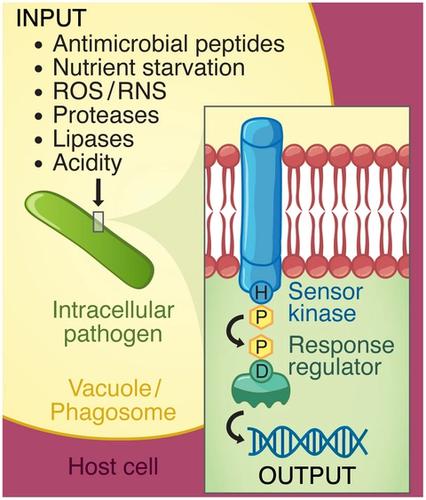当前位置:
X-MOL 学术
›
Mol. Microbiol.
›
论文详情
Our official English website, www.x-mol.net, welcomes your
feedback! (Note: you will need to create a separate account there.)
Two-component sensor histidine kinases of Mycobacterium tuberculosis: Beacons for niche navigation
Molecular Microbiology ( IF 2.6 ) Pub Date : 2022-03-26 , DOI: 10.1111/mmi.14899 Miljan Stupar 1 , Juanelle Furness 1 , Christopher J De Voss 1 , Lendl Tan 1 , Nicholas P West 1
Molecular Microbiology ( IF 2.6 ) Pub Date : 2022-03-26 , DOI: 10.1111/mmi.14899 Miljan Stupar 1 , Juanelle Furness 1 , Christopher J De Voss 1 , Lendl Tan 1 , Nicholas P West 1
Affiliation

|
Intracellular bacterial pathogens such as Mycobacterium tuberculosis are remarkably adept at surviving within a host, employing a variety of mechanisms to counteract host defenses and establish a protected niche. Constant surveying of the environment is key for pathogenic mycobacteria to discern their immediate location and coordinate the expression of genes necessary for adaptation. Two-component systems efficiently perform this role, typically comprised of a transmembrane sensor kinase and a cytoplasmic response regulator. In this review, we describe the role of two-component systems in bacterial pathogenesis, focusing predominantly on the role of sensor kinases of M. tuberculosis. We highlight important features of sensor kinases in mycobacterial infection, discuss ways in which these signaling proteins sense and respond to environments, and how this is attuned to their intracellular lifestyle. Finally, we discuss recent studies which have identified and characterized inhibitors of two-component sensor kinases toward establishing a new strategy in anti-mycobacterial therapy.
中文翻译:

结核分枝杆菌的双组分传感器组氨酸激酶:用于生态位导航的信标
细胞内细菌病原体如结核分枝杆菌非常擅长在宿主内生存,采用多种机制来抵消宿主防御并建立受保护的生态位。对环境的持续调查是致病性分枝杆菌识别其直接位置并协调适应所需基因表达的关键。双组分系统有效地发挥了这一作用,通常由跨膜传感器激酶和细胞质反应调节剂组成。在这篇综述中,我们描述了双组分系统在细菌发病机制中的作用,主要关注结核分枝杆菌传感器激酶的作用. 我们强调了分枝杆菌感染中传感器激酶的重要特征,讨论了这些信号蛋白感知和响应环境的方式,以及这如何与它们的细胞内生活方式相协调。最后,我们讨论了最近的研究,这些研究已经确定并表征了双组分传感器激酶的抑制剂,以建立抗分枝杆菌治疗的新策略。
更新日期:2022-03-26
中文翻译:

结核分枝杆菌的双组分传感器组氨酸激酶:用于生态位导航的信标
细胞内细菌病原体如结核分枝杆菌非常擅长在宿主内生存,采用多种机制来抵消宿主防御并建立受保护的生态位。对环境的持续调查是致病性分枝杆菌识别其直接位置并协调适应所需基因表达的关键。双组分系统有效地发挥了这一作用,通常由跨膜传感器激酶和细胞质反应调节剂组成。在这篇综述中,我们描述了双组分系统在细菌发病机制中的作用,主要关注结核分枝杆菌传感器激酶的作用. 我们强调了分枝杆菌感染中传感器激酶的重要特征,讨论了这些信号蛋白感知和响应环境的方式,以及这如何与它们的细胞内生活方式相协调。最后,我们讨论了最近的研究,这些研究已经确定并表征了双组分传感器激酶的抑制剂,以建立抗分枝杆菌治疗的新策略。











































 京公网安备 11010802027423号
京公网安备 11010802027423号